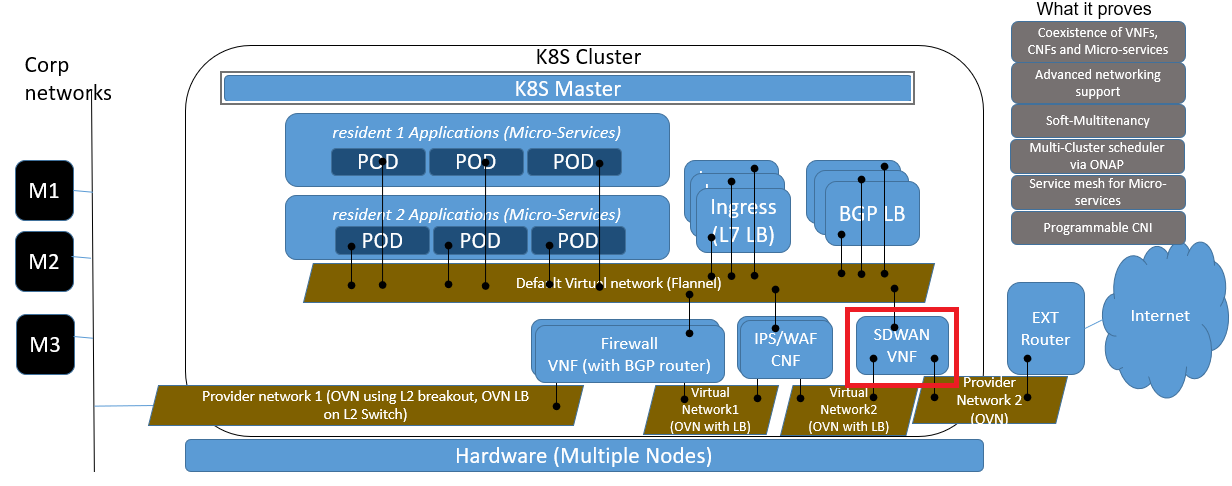| Table of Contents |
|---|
In ICN's SDWAN usages, SFC (Service Function Chain) is designed to support Corp networks to connect to external internet with security connection. The SFC includes Security VNF (e.g. firewall etc.), WAN Opt CNF and SDWAN VNF/CNF, and SDWAN module is worked as software defined router which can be used to defined the rules when connect to external internet. Below diagram shows where SDWAN module located in the whole system.
Basic Technologies
...
OpenWRT
The OpenWRT Project (https://openwrt.org/) is an open source project based on Linux, and it is primarily used on embedded devices to route network traffic. There are more than 3500 software packages which can be installed on OpenWRT via opkg package management system. OpenWRT provides both docker image and VM image to support virtualization solution (https://openwrt.org/docs/guide-user/virtualization/start). In ICN, we run OpenWRT in container.
OpenWRT Mwan3 package (a replacement for multiwan package) provides the capabilities for multiple WAN management: WAN interfaces management, outbound traffic rules, traffic load balancing etc.
Design Proposals
Implementation
SDWAN module is implemented as CNF instead of VNF for better performance and proving of CNF can also be effect way to deploy SDWAN
SDWAN will leverage OpenWRT for it functionality:
- Base Image: x86-generic rootfs image (http://downloads.openwrt.org/releases/18.06.4/targets/x86/generic/)
- Packages:
- mwan3: multiple wans configuration and management
- luci-app-mwan3: web configuration interface for mwan3
- uhttp: web server for luci services
Deployment
Helm will be used to deploy SDWAN CNF as pod on nodes with external network connection with below parameters:
...
WAN interface definition (e.g. interface, member etc.)
ovn4nfv-k8s-plugin
ovn4nfv-k8s-plugin is a CNI plugin based on ovn. It can work together with Multus CNI to add multiple interfaces for the pod. One of the interfaces is the Multus default interface, it could be flannel, calico, etc. The other interfaces are added by ovn4nfv-k8s-plugin according the the pod annotation. With ovn4nfv-k8s-plugin, we can create virtual network in run-time. Also we can connect the pod with the provider network, this is important for CNF.
Design Overview
SDEWAN is a solution to enable SDWAN functionalities include multiple WAN link support, WAN traffic management, NAT, firewall, IPSec and Traffic shaping etc. with focus to address the challenges when applying on edge computing environment like resource limitation, edge overlays, traffic sanitization, automation and cost sensitive etc. The solution includes below components:
- SDEWAN CNF: implemented based on OpenWRT, it enhances OpenWRT Luci web interface with SDEWAN controllers to provide Restful API for network functions' configuration and control.
- SDEWAN CRD Controller: implemented as k8s CRD Controller, it manages CRDs (e.g. Firewall related CRDs, Mwan3 related CRDs and IPSec related CRDs etc.) and internally calls SDEWAN Restful API to do CNF configuration.
- Overlay Controller: provides central control of SDEWAN overlay networks by automatically configuring the SDEWAN CNFs through SDEWAN CRD controller located in edge location clusters and hub clusters.
SDEWAN CNF
Sdewan CRD Controller
Presentation
ICN Weekly meeting video recordings- Weekly Akraino ICN Engineering Meeting
...
config interface 'wan' option enabled '1' list track_ip '8.8.4.4' list track_ip '8.8.8.8' list track_ip '208.67.222.222' list track_ip '208.67.220.220' option reliability '2' option count '1' option timeout '2' option interval '5' option down '3' option up '8'
config member 'wan_m1_w3' option interface 'wan' option metric '1' option weight '3'
Initial Traffic rules (e.g. policy, rule etc.)
...
config policy 'wan_only' list use_member 'wan_m1_w3'
config rule 'sticky_even' option src_ip '0.0.0.0/0.0.0.1' option dest_port '443' option proto 'tcp' option use_policy 'wan_only'
Runtime Configuration
SDWAN traffic rules and WAN interfaces are required to be configured at runtime through Restful API interface, this supposed can be supported by luci-app-mwan3, require more investigation for details.
OpenWRT luci invoking mechanism:
(1) logon: POST /cgi-bin/luci with luci_username and luci_password to get sysauth Cookie
e.g. wget --post-data "luci_username=root&luci_password=" http://192.168.56.2/cgi-bin/luci/
response header will include sysauch cookie, like: "Set-Cookie: sysauth=e5b2e5c2ae0099c078bb3cb72052ed95;"
(2) Call luci http service with sysauth Cookie
e.g. wget --header="Cookie:sysauth=e5b2e5c2ae0099c078bb3cb72052ed95" http://192.168.56.2/cgi-bin/luci
Mwan3 supported services:
- interface_status: GET /luci/admin/status/mwan/interface_status
- detaild_status: GET /luci/admin/status/mwan/detailed_status
- diagnostics_display: GET /luci/admin/status/mwan/diagnostics_display
- troubleshooting_display: GET /luci/admin/status/mwan/troubleshooting_display
Note: configuration for WAN's interface, member, policy and rule are supported in the web UI, but with no direct restful API available. It needs implement luci cgi plugin to provide restful API for WAN configuration.
QAT support
QAT support is required for hardware acceleration of https
Implementations
TBD.
